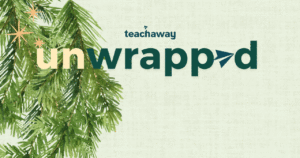If you’re just starting to research teaching English abroad – and don’t have all the lingo down yet – you may be asking yourself: what’s a TEFL certificate?
Well, if you’re dreaming of teaching English abroad and seeing the world, a TEFL certificate is your ticket to making your dreams come true – it was for me!
TEFL is short for Teaching English as a Foreign Language, so (as you may have guessed) a TEFL certificate qualifies you to teach English in non-English speaking countries.
If you want to learn all about TEFL certification, you’ve come to the right place! Keep reading to find out more about what it is and why it’s so essential to landing a teaching job abroad.
Before we dive deeper into all things TEFL, I’d like to clear up something that often causes confusion: the difference between TEFL and TESL (Teaching English as a Second Language).
These two terms are often used interchangeably, even though they technically have different meanings.
Sometimes TESOL (Teaching English to Speakers of Other Languages) is also thrown into the mix, causing even more confusion.
What’s the difference between TEFL, TESL and TESOL?
- TEFL = teaching English in non-English-speaking countries (e.g. teaching children in China)
- TESL = teaching English to students in English-speaking countries whose first language is not English (e.g. teaching new immigrants in Canada)
- TESOL = general term that includes both TEFL and TESL
When you start looking for a job abroad with your TEFL certificate in hand, you’ll likely find that many job posts are for “ESL teachers,” but don’t worry!
If the position is in a non-English-speaking country, then it’s actually for an EFL teacher – which you’re perfectly qualified for.
You’ll see the terms used interchangeably on our job board, so make sure to keep this in mind during your job search.
Ok, time to get down to the task at hand and talk about why you need a TEFL certificate to land your dream teaching job abroad.
1. A TEFL certificate is a common requirement for most teaching jobs abroad.
Job requirements for ESL teaching jobs abroad vary across countries, but for the most part, a TEFL certification is a required qualification for most jobs at reputable schools.
A Bachelor’s degree is also a very common requirement across the board, but you don’t need a degree in education or previous teaching experience in order to teach English abroad.
For instance, after majoring in history and political science in university, I graduated with a Bachelor of Arts and quickly landed an English teaching job in China solely based on my completion of a TEFL course.
Also, keep in mind that the ESL job market is highly competitive. So without a TEFL certificate, you’ll be at a distinct disadvantage.
Even for job openings where the hiring school has not explicitly listed a TEFL certification as a requirement, it is always noticed and could be the deciding factor between hiring you or another teaching candidate.
Good schools are looking to hire teachers with proper training, so they won’t consider you to be a viable candidate if you don’t have a TEFL certificate.
2. A TEFL certificate trains you on how to teach English to foreign students.
Even for native English speakers, figuring out how to teach English to speakers of other languages is not so simple.
There are many things that come naturally to us, which are difficult to explain – English grammar in particular.
When interviewing for teaching jobs abroad, you‘ll be expected to demonstrate a strong grasp of fundamental English teaching skills – skills that can only be gained through getting TEFL certified.
A TEFL course covers the ins and outs of ESL teaching, including lesson planning, classroom management and how to teach English language skills like reading, writing, speaking, listening, pronunciation and grammar.
It also equips you with essential skills for the foreign language classroom, like how to identify different learning styles and adapt lessons to suit different student needs.
3. A TEFL certificate can help you develop the confidence to command a classroom.
If you’ve never taught before, standing in front of a classroom full of students can be pretty intimidating – especially if you feel like you have no idea what you’re doing.
This is amplified by the fact that your students may not speak a word of English, so you’ll likely have no idea how to communicate with them.
When I first started teaching in China, I had classes of young learners (some as young as four years old) who not only didn’t speak English, but some of them had never even met a foreigner before.
They were super cute, but the language barrier was so overwhelming for them that at least one student ended up in tears by the end of each lesson.
Luckily, my TEFL training had prepared me for this scenario and I was able to (mostly) keep things under control.
Taking the leap to teach abroad can be scary, so make sure you’re as prepared for the challenges you will inevitably face teaching students who don’t speak the same language as you.
Completing a TEFL course is the best investment you can make if you want to be as prepared as possible.
It’ll set you up for teaching success by giving you the knowledge and confidence to lead engaging lessons and command a classroom.

4. A TEFL certificate can help you develop skills for working and living in a foreign country.
When you first move abroad to teach, you may experience some culture shock – whether you expect it or not.
That’s why some TEFL courses equip you with intercultural skills that will help you navigate smoothly through life in and outside of the classroom in a foreign country.
How to get started with a TEFL certificate
Enrolling in a TEFL course is super easy! There are no prerequisites and you can start online right away. Even if you’re a student planning your next step, you can even get TEFL certified while you’re still in school.
But you may want to do some research first. Personally, I wish I had done more research before signing up for an in-class TEFL course, which was unnecessarily intensive and not as informative as I had hoped.
Mind you, that was 11 years ago, so my TEFL course choices were limited. Nowadays there are so many choices out there that picking the best one can be tricky. So make sure to research how to choose the right TEFL course for you.
Don’t forget that a TEFL course is an investment in your future, which will help you land a well-paying teaching job.
Not only can you earn a lot, but also save money, while enjoying living abroad. Sounds pretty awesome, right? I can honestly tell you from personal experience: it really is!
One last pro tip: keep an eye out for discount promotions that some TEFL companies offer every so often. You’ll likely save more than you’d expect.
And you can put that money towards your travel fund!





